User talk:Leo1pard/sandbox/Tiger versus lion
Page views
[edit]| Graphs are unavailable due to technical issues. Updates on reimplementing the Graph extension, which will be known as the Chart extension, can be found on Phabricator and on MediaWiki.org. |
Leo1pard (talk) 11:16, 7 December 2016 (UTC)
Subspecies of lions and tigers
[edit]Tigers
[edit]| Subspecies | Description | Image |
|---|---|---|
| Bengal tiger (P. t. tigris), also called the Indian tiger | Lives in Bangladesh, Bhutan, India, Nepal and is the most common subspecies. In 2011, the total adult population was estimated at 1,520–1,909 in India, 440 in Bangladesh, 155 in Nepal and 75 in Bhutan.[1] In 2014, the population in India was estimated at 2,226,[2] 163–253 in Nepal and 103 in Bhutan as of 2015.[3] It lives in alluvial grasslands, subtropical and tropical rainforests, scrub forests, wet and dry deciduous forests, and mangroves. In terms of average and maximum recorded weights in the wilderness,[4][5] it is the heaviest of the surviving subspecies. Males attain a total nose-to-tail length of 270 to 310 cm (110 to 120 in) and weigh between 180 to 258 kg (397 to 569 lb), while females range from 240 to 265 cm (94 to 104 in) and 100 to 160 kg (220 to 350 lb).[6][7] In northern India and Nepal, the average is larger; males can weigh up to 235 kilograms (518 lb), while females average 140 kilograms (310 lb).[8] Coat colour varies from light yellow to reddish yellow with black stripes.[9]
|
 |
| Caspian tiger (P. t. virgata), also known as the Hyrcanian tiger, Persian tiger or Turanian tiger | Was found in the sparse forest habitats and riverine corridors south and east of the Black and Caspian Seas, through the Pontic-Caspian steppe into Central Asia, and onto the Takla-Makan desert of Xinjiang.[10] The Caspian tiger had been recorded in the wild until the early 1970s.[11] The extant Siberian tiger is the genetically closest living relative of this recognised subspecies.[12]
|
 |
| Siberian tiger (P. t. altaica), also known as the Amur tiger | Inhabits the Amur-Ussuri region of Primorsky Krai and Khabarovsk Krai in far eastern Siberia, with the exception of a small population in Hunchun National Siberian Tiger Nature Reserve in northeastern China, near the border of North Korea.[13][14] In 2005, there were 331–393 adult and subadult Siberian tigers in the region, with a breeding adult population of about 250 individuals. As of 2015, there an estimated population of 480-540 individuals in the Russian Far East.[15][16][17] It is the largest subspecies, judging by the maximum recorded weight of a tiger in captivity,[5] and ranks among the largest felids ever to have existed. Males have a head and body length of between 190–230 cm (75–91 in) and weigh between 180 to 306 kg (397 to 675 lb), while females average 160–180 cm (63–71 in) and 100 to 167 kg (220 to 368 lb). Tail length is about 60–110 cm (24–43 in).[6] Compared to other subspecies, Siberian tigers have thicker coats, paler hues, and fewer stripes in dark brown instead of black.[9][18][19]
|
 |
| Indochinese tiger (P. t. corbetti), also called Corbett's tiger | Is found in Cambodia, China, Laos, Burma, Thailand, and Vietnam. In 2010 the total population was estimated at about 350 individuals.[20] Their preferred habitat is forests in mountainous or hilly regions.[6] Males average 108 inches (270 cm) in total length and weigh between 150–195 kg (331–430 lb), while females average 96 inches (240 cm) and 100–130 kg (220–290 lb).[18] |  |
| Malayan tiger (P. t. jacksoni) | Exclusively found in the southern part of the Malay Peninsula. The last native wild tiger in Singapore was shot dead in 1930.[21] Was not considered a subspecies in its own right until a 2004 genetic analysis showed that they are distinct in mtDNA and micro-satellite sequences from the Indochinese subspecies.[22] As of 2014 the total population is estimated at fewer than 500 individuals,[23] though a new report from September that year estimated it at between 250 and 340 individuals.[24] Males range in total length from 190–280 cm (75–110 in) and weigh between 47.2 to 129.1 kg (104 to 285 lb), while females range from 180–260 cm (71–102 in) and 24 to 88 kg (53 to 194 lb).[25] | 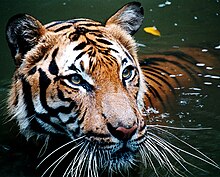 |
| South China tiger (P. t. amoyensis), also known as the Amoy tiger or Xiamen tiger | Is the most critically endangered subspecies of tiger, and one of the 10 most endangered animals in the world.[18] Despite unconfirmed reports and some evidence of footprints, there has been no confirmed wild sighting in over 25 years, leading experts to consider it "functionally extinct", with the entire known population of roughly 65+ individuals held in captivity.[26][27] It is the second-smallest subspecies. Males range in total length from 230–260 cm (91–102 in) and weigh between 130 to 180 kg (290 to 400 lb), while females range from 220–240 cm (87–94 in) and 100 to 110 kg (220 to 240 lb). The South China tiger is considered to be the most ancient of the tiger subspecies and is distinguished by a particularly narrow skull, long muzzle nose, rhombus-like stripes and vivid orange colour.[18] | 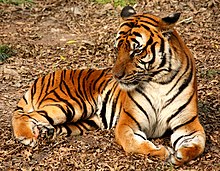 |
| Subspecies | Description | Image |
|---|---|---|
| Sumatran tiger (P. t. sumatrae) | Found only on the island of Sumatra, and is thus the last surviving of the three Indonesian island subspecies. Listed as a distinct subspecies as of 1998, when genetic testing revealed the presence of unique genetic markers, and is critically endangered.[28] As of 2014 the wild population is estimated at between 400 and 500, seen chiefly in the island's national parks.[29][30] It is the smallest of all living tigers. Males range in total length from 220 to 255 cm (87 to 100 in) and weigh between 100 to 140 kg (220 to 310 lb), while females range between 215 to 230 cm (85 to 91 in) and 75 to 110 kg (165 to 243 lb).[6] Their reduced size is an adaptation to the thick, dense forests and smaller prey in their native habitat. This subspecies also has the darkest coat, with more narrowly spaced stripes and a longer mane and beard.[18][19]
|
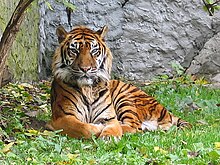 |
| Javan tiger (P. t. sondaica) | Was limited to the island of Java, and had been recorded until the mid-1970s.[31] Javan tigers were larger than Bali tigers; males weighed 100–141 kg (220–311 lb) and females 75–115 kg (165–254 lb).[32] After 1979, no more sightings were confirmed in the region of Mount Betiri.[33] An expedition to Mount Halimun Salak National Park in 1990 did not yield any definite, direct evidence for the continued existence of tigers.[34]
|
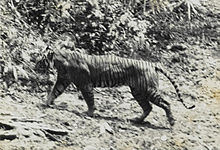 |
| Bali tiger (P. t. balica) | Was limited to the Indonesian island of Bali. Had a weight of 90–100 kg (200–220 lb) in males and 65–80 kg (143–176 lb) in females.[35] Bali tigers were hunted to extinction; the last Bali tiger, an adult female, is thought to have been killed at Sumbar Kima, West Bali, on 27 September 1937, though there were unconfirmed reports that villagers found a tiger corpse in 1963.[36] The Bali tiger is reported to have had some spots in between its stripes.[18]
|
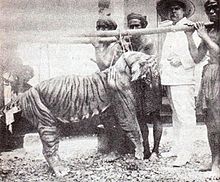 |
African lions
[edit]| Subspecies | Description | Image |
|---|---|---|
| Barbary lion, Atlas lion or North African lion (P. l. leo)[37][38] (Linnaeus, 1758), syn. P. l. nubica (de Blainville, 1843), P. l. somaliensis (Noack, 1891)[39] P. l. webbiensis Zukowsky, 1964 | This is the nominate lion subspecies. In North Africa, lions are locally extinct in the wild due to excessive hunting; the last known Barbary lion was killed in Morocco in 1920.[40][41]
A few captive lions are likely from North Africa, particularly the 90 individuals descended from the Moroccan Royal collection at Rabat Zoo.[42][43] It is genetically more closely related to the Asiatic lion than to lions in East and Southern Africa.[44] This population occurred in Morocco, Algeria, Libya and Tunisia, at least.[45] Today, lions are extinct in North Africa.[38] |
 |
| Subspecies | Description | Image |
|---|---|---|
| Congo lion or Northeast Congo lion[46] (P. l. azandica) (Allen, 1924)[39] | The type specimen was a male lion from northeastern Belgian Congo.[45]
Lions survive in the northeastern parts of the Democratic Republic of the Congo. They are locally extinct in the Republic of the Congo.[38] |
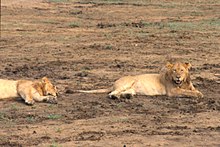 |
| Subspecies | Description | Image |
|---|---|---|
| Senegal lion or West African lion (P. l. senegalensis) (Meyer, 1826),[39] | The type specimen originated in Senegal.[47]
This population has been listed as Critically Endangered in 2015 and survives in West Africa from Senegal, Burkina Faso, Benin to Niger and Nigeria. It is possibly extinct in Mauritania, Mali, Ghana, Guinea, Côte d'Ivoire, Gambia, Guinea-Bissau, Sierra Leone and Togo.[48][49] |
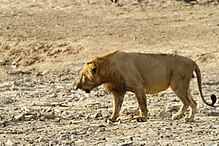 |
| Cameroon lion (P. l. kamptzi (Matschie, 1900)[47] | From Cameroon and the region south of Lake Chad.[50] |  |
| Subspecies | Description | Image |
|---|---|---|
| Cape lion (P. l. melanochaita)[37] (Smith, 1842)[39] | The type specimen originated at the Cape of Good Hope.[51] The population lived in the Cape Province and Natal, South Africa.[52] |  |
| Kalahari lion (P. l. vernayi) | Found in the Kalahari Region of Southern Africa.[53] |  |
| Katanga lion or Southwest African lion (P. l. bleyenberghi) (Lönnberg, 1914)[39] | The type specimen originated in the Katanga Province of the former Belgian Congo.[54]
In southwestern Africa lions occur in Namibia and northern Botswana. In the southwestern part of the Democratic Republic of the Congo, they are considered regionally extinct.[38] |
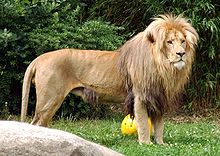 |
| Transvaal lion or Southeast African lion (P. l. krugeri) (Roberts, 1929), syn. P. l. vernayi (Roberts, 1948)[39] | The type specimen was an adult male lion shot in 1925 in the Kruger National Park.[55] A yellow-maned male specimen shot in the Kalahari was described in 1948.[56]
This population lives in Southern Africa from South Africa, Swaziland, Botswana, Zimbabwe to Mozambique.[57] |
 |
| Subspecies | Description | Image |
|---|---|---|
| Egyptian lion (P. l. nubica or P. l. leo) | Heptner and Sludskii (1972)[58] treated the Egyptian lion as a population of the Barbary subspecies, but at the same time, Egypt has a section of Nubia. Both Nubia and Egypt are in Northeast Africa,[59] they are neither exclusively Eastern nor Northern African. Whether or not the Egyptian lion is the Nubian lion needs research. |  |
| Ethiopian lion (P. l. roosevelti), also known as Abyssinian lion and Addis Ababa lion | 15 captive lions in Ethiopia's capital city of Addis Ababa.[60] Researchers compared the microsatellite variations over ten loci of fifteen lions in captivity with those of six different wild lion populations. They determined that these lions are genetically unique and presumably that "their wild source population is similarly unique." These lions were part of a collection of the late Haile Selassie I of Ethiopia.[61] |  |
| Nubian lion (P. l. nubica) | From Nubia.[50] | 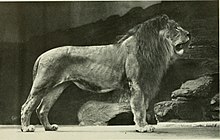 |
| Somali lion (P. l. somaliensis syn. P. l. webbiensis) | From Somaliland or Somalia, East Africa.[62][45] |  |
| Subspecies | Description | Image |
|---|---|---|
| P. l. sabakiensis | From the vicinity of Mount Kilimanjaro in East Africa.[63] |  |
| Masai lion (P. l. massaica) (Neumann, 1900), syn. P. l. hollisteri (Allen, 1924), P. l. sabakiensis (Lönnberg, 1910), P. l. roosevelti (Heller, 1913)[39] | The type specimens originated in the Tanganyika Territory, in the environs of Mount Kilimanjaro and in the Ethiopian Highlands.[52] A local population is known as the Tsavo lion.
This population occurs in East Africa from Ethiopia, Uganda, Kenya and Tanzania to Mozambique. Lions are locally extinct in South Sudan, Djibouti, Eritrea and Rwanda.[38] |
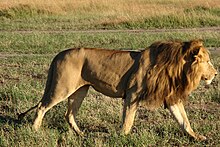 |
| P. l. hollisteri (Allen, 1924)[39] | The type specimen was male adult lion from the eastern shore of Lake Victoria in Kenya.[45] |  |
| Uganda lion (P. l. nyanzae) (Heller, 1913),[39] | The type specimen was a lion skin without skull from the northern shore of Lake Victoria in Uganda.[45] |  |
| Subspecies | Description | Image |
|---|---|---|
| P. l. leo[37][38] (Linnaeus, 1758)[39] | Lions in Western, Central and Northern Africa, and Asia. |  |
| P. l. melanochaita[37] (Smith, 1842)[39] | Lions in Eastern and Southern Africa. |  |
Discussion
[edit]Hi, in case anyone is considering editing this article to reflect the Cat Specialist Group's recent classification of lions in Northern, Western and Central Africa to P. l. leo, and those in Eastern and Southern Africa to P. l. melanochaita, and tigers in Mainland Asia to P. t. tigris, and those in the Sunda Islands to P. t. sondaica,[64] I would like to caution against it for the following reasons:
1) Extensive literature has already been written on topics, such as that of coexistence of Asiatic lions and Bengal and Caspian tigers, and their reported weights. If you were to try to merge the subsections "Asiatic lion and Bengal tiger" and "Asiatic lion and Caspian tiger" to get "Asiatic lion and Mainland Asian tiger," then imagine how bulky that subsection would be, for example.
2) The CSG's classification is not without controversy, for reasons mentioned in the talk pages of articles like Lion and Panthera.
Unless you are adding new information, or have to use the new classification. For example, I would call those lions in Mashonaland, in the section about the lengths of lions and tigers, as 'Melanochaitan' lions (P. l. melanochaita), not 'Leonine' lions (P. l. leo), based on this map by Bertola et al.,[65] and in case you are confused about it, let me elaborate later.
I am not saying that you have to talk about those lions in Mashonaland being 'Melanochaitan' lions, that is to give you an idea. Now, as for this issue of 'Leonine' or 'Melanochaitan' lions, it is like this, the Cat Specialist Group subsumed lions in Asia and Northern, Western and Central Africa to P. l. leo, and those in Eastern and Southern Africa to P. l. melanochaita, but, as I have said elsewhere, that classification is not as simple as it sounds. Firstly, let us define the 'Leonine' or 'Leonic' clade of lions (P. l. leo) as the clade which includes Asian, Barbary and West African lions, and the 'Melanochaitan' clade as that of lions in Eastern and Southern Africa, and includes Cape and Tsavo lions. One issue with the classification by the CSG is that the Leonic and Melanochaitan clades overlap in Eastern or Northeastern Africa, so how would you classify lions in those areas, such as the Ethiopian lion? Another issue is that some Eastern-Southern African lions, hence Melanochaitan lions, are in Central Africa, as shown by this map by Bertola et al.,[65] so it is wrong to treat all Central African lions as being Leonic. That said, it appears that the African lion, never mind the lion in general, is more complicated than the tiger, phylogeographically and taxonomically, even a glance at the tables above should give that impression. In particular, Dubache et al. (2005) said that nine subspecies were named for lions in East Africa![66]
References
- ^ Lynam, A.J.; Nowell, K. (2011). "Panthera tigris ssp. corbetti". IUCN Red List of Threatened Species. 2011: e.T136853A4346984. doi:10.2305/IUCN.UK.2011-2.RLTS.T136853A4346984.en. Retrieved 27 October 2020.
- ^ Cite error: The named reference
Burkewas invoked but never defined (see the help page). - ^ "Bhutan's tigers". World Wide Fund For Nature (WWF). Archived from the original on 2016-03-04. Retrieved 29 November 2015.
- ^ Slaght, J. C., D. G. Miquelle, I. G. Nikolaev, J. M. Goodrich, E. N. Smirnov, K. Traylor-Holzer, S. Christie, T. Arjanova, J. L. D. Smith, Karanth, K. U. (2005) Chapter 6. Who's king of the beasts? Historical and recent body weights of wild and captive Amur tigers, with comparisons to other subspecies. Pages 25–35 in: Miquelle, D.G., Smirnov, E.N., Goodrich, J.M. (Eds.) Tigers in Sikhote-Alin Zapovednik: Ecology and Conservation. PSP, Vladivostok, Russia (in Russian)
- ^ a b Wood, Gerald (1983). The Guinness Book of Animal Facts and Feats. Guinness Superlatives. ISBN 978-0-85112-235-9.
- ^ a b c d Cite error: The named reference
Mazak1981was invoked but never defined (see the help page). - ^ Karanth, K. U. (2003). Tiger ecology and conservation in the Indian subcontinent. Journal of the Bombay Natural History Society 100 (2&3) 169–189.
- ^ Smith, J. L. David; Sunquist, M. E.; Tamang, K. M.; Rai, P. B. (1983). "A technique for capturing and immobilizing tigers". The Journal of Wildlife Management. 47 (1): 255–259. doi:10.2307/3808080. JSTOR 3808080. Table 1 entries on page 257 are Adult females N=19 mean=140 Range=116–164, Adult males N=7 mean=235 Range=200–261.
- ^ a b Brakefield, Tom (1993). Big Cats: Kingdom of Might. Voyageur Press. p. 44. ISBN 978-0-89658-329-0.
- ^ Cite error: The named reference
ReferenceAwas invoked but never defined (see the help page). - ^ Jackson, P.; Nowell, K. (2011). "Panthera tigris ssp. virgata". IUCN Red List of Threatened Species. 2011: e.T41505A10480967. doi:10.2305/IUCN.UK.2011-2.RLTS.T41505A10480967.en. Retrieved 27 October 2020.
- ^ Driscoll, C. A.; Yamaguchi, N.; Bar-Gal, G. K.; Roca, A. L.; Luo, S.; MacDonald, D. W.; O'Brien, S. J. (2009). Brembs, Björn (ed.). "Mitochondrial Phylogeography Illuminates the Origin of the Extinct Caspian Tiger and Its Relationship to the Amur Tiger". PLoS ONE. 4 (1): e4125. doi:10.1371/journal.pone.0004125. PMC 2624500. PMID 19142238.
{{cite journal}}: CS1 maint: unflagged free DOI (link) - ^ Kerley, L.L.; Goodrich, J.M. Miquelle; D.G. Smirnov; E.N. Quigley; H.G., Hornocker, M.G. (2003). "Reproductive parameters of wild female Amur (Siberian) tigers (Panthera tigris altaica)". Journal of Mammalogy. 84: 288–298. doi:10.1644/1545-1542(2003)084<0288:RPOWFA>2.0.CO;2. JSTOR 1383657.
{{cite journal}}: CS1 maint: multiple names: authors list (link) - ^ Kaiman, Jonathan (24 May 2013). "China reports rise in humans encountering wild Siberian tigers". The Guardian. Retrieved 10 April 2014.
- ^ Miquelle, D.; Darman, Y.; Seryodkin, I. (2011). "Panthera tigris ssp. altaica". IUCN Red List of Threatened Species. 2011: e.T15956A5333650. doi:10.2305/IUCN.UK.2011-2.RLTS.T15956A5333650.en. Retrieved 27 October 2020.
- ^ "Species: Amur tiger". World Wildlife Fund. Retrieved 10 April 2014.
- ^ "Russia Announce Tiger Census Results!". tigers.panda.org. World Wide Fund for Nature. 27 May 2015. Retrieved 7 June 2015.
- ^ a b c d e f "Tiger Facts". Save China's Tigers. Archived from the original on 2014-08-29. Retrieved 10 April 2014.
- ^ a b Hammond, Paul (2010). The Atlas of Endangered Animals: Wildlife Under Threat Around the World. Marshall Cavendish. p. 86. ISBN 978-0-7614-7872-0.
- ^ "Species: Indochinese tiger". World Wildlife Fund. Retrieved 10 April 2014.
- ^ a b "Lion City, Tiger Land: Singapore's Native Cat on the Brink of Extinction". latitudes.nu. Retrieved 31 May 2016.
- ^ Luo, S.-J.; Kim, J.-H.; Johnson, W. E.; van der Walt, J.; Martenson, J.; Yuhki, N.; Miquelle, D. G.; Uphyrkina, O.; Goodrich, J. M.; Quigley, H. B.; Tilson, R.; Brady, G.; Martelli, P.; Subramaniam, V.; McDougal, C.; Hean, S.; Huang, S.-Q.; Pan, W.; Karanth, U. K.; Sunquist, M.; Smith, J. L. D.; O'Brien, S. J. (2004). "Phylogeography and genetic ancestry of tigers (Panthera tigris)". PLoS Biology. 2 (12): e442. doi:10.1371/journal.pbio.0020442. PMC 534810. PMID 15583716.
{{cite journal}}: CS1 maint: unflagged free DOI (link) - ^ "Species: Malayan tiger". World Wildlife Fund. Retrieved 10 April 2014.
- ^ Hance, Jeremy (September 2014). "Malayan tiger population plunges to just 250-340 individuals". Mongabay.com. Retrieved 17 July 2016.
- ^ Khan, M.K.M. (1986). "Tigers in Malaysia" (PDF). Journal of Wildlife and Parks. V: 1–23.
- ^ "South China tiger believed to still exist in wild". China.org.cn. Xinhua News Agency. 15 July 2007. Retrieved 3 April 2014.
- ^ "Species: South China tiger". World Wildlife Fund. Retrieved 10 April 2014.
- ^ Linkie, M.; Wibisono, H.T.; Martyr, D.J.; Sunarto, S. (2008). "Panthera tigris ssp. sumatrae". IUCN Red List of Threatened Species. 2008: e.T15966A5334836. doi:10.2305/IUCN.UK.2008.RLTS.T15966A5334836.en. Retrieved 27 October 2020.
- ^ "Species: Sumatran tiger". World Wildlife Fund. Retrieved 10 April 2014.
- ^ Cracraft, Joel; Feinstein, Julie; Vaughn, Jeffrey; Helm-Bychowski, Kathleen (1998). "Sorting out tigers (Panthera tigris): mitochondrial sequences, nuclear inserts, systematics, and conservation genetics" (PDF). Animal Conservation. 1 (2): 139–150. doi:10.1111/j.1469-1795.1998.tb00021.x.
- ^ Jackson, P.; Nowell, K. (2008). "Panthera tigris ssp. sondaica". IUCN Red List of Threatened Species. 2008: e.T41681A10509194. doi:10.2305/IUCN.UK.2008.RLTS.T41681A10509194.en. Retrieved 27 October 2020.
- ^ Mazák, J.H.; Groves, C.P. (2006). "A taxonomic revision of the tigers (Panthera tigris)" (PDF). Mammalian Biology. 71 (5): 268–287. doi:10.1016/j.mambio.2006.02.007. Archived from the original (PDF) on 6 September 2007.
{{cite journal}}: Unknown parameter|deadurl=ignored (|url-status=suggested) (help) - ^ Seidensticker, J. (1987). "Bearing Witness: Observations on the Extinction of Panthera tigris balica and Panthera tigris sondaica". pp. 1–8 in: Tilson, R. L., Seal, U. S. (eds.) Tigers of the World: the biology, biopolitics, management, and conservation of an endangered species. Noyes Publications, New Jersey, ISBN 0-8155-1133-7.
- ^ Istiadi, Y.; Panekenan, N.; Priatna, D.; Novendri, Y.; Mathys, A.; Mathys, Y. (1991). "Untersuchung über die Carnivoren des Gunung Halimun Naturschutzgebietes". Zoologische Gesellschaft für Arten- und Populationsschutz e.V. Mitteilungen. 7 (2): 3–5.
- ^ Cite error: The named reference
der-tigerwas invoked but never defined (see the help page). - ^ Whitten, Tony; Soeriaatmadja, Roehayat Emon (1996). Ecology of Java & Bali. Oxford University Press. p. 706. ISBN 978-962-593-072-5.
- ^ a b c d Cite error: The named reference
catsgwas invoked but never defined (see the help page). - ^ a b c d e f Cite error: The named reference
IUCNwas invoked but never defined (see the help page). - ^ a b c d e f g h i j k Cite error: The named reference
MSW3was invoked but never defined (see the help page). - ^ Nowell, K.; Jackson, P. (1996). "Panthera leo". Wild Cats: Status Survey and Conservation Action Plan (PDF). Gland, Switzerland: IUCN/SSC Cat Specialist Group. pp. 17–21, 37–41. ISBN 2-8317-0045-0.
- ^ Black, S. A.; Fellous, A.; Yamaguchi, N.; Roberts, D. L. (2013). "Examining the Extinction of the Barbary Lion and Its Implications for Felid Conservation". PLOS ONE. 8 (4): e60174. Bibcode:2013PLoSO...860174B. doi:10.1371/journal.pone.0060174. PMC 3616087. PMID 23573239.
{{cite journal}}: CS1 maint: unflagged free DOI (link) - ^ Burger, J.; Hemmer, H. (2006). "Urgent call for further breeding of the relic zoo population of the critically endangered Barbary lion (Panthera leo leo Linnaeus 1758)" (PDF). European Journal of Wildlife Research. 52: 54–58. doi:10.1007/s10344-005-0009-z.
- ^ Black, S.; Yamaguchi, N.; Harland, A.; Groombridge, J. (2010). "Maintaining the genetic health of putative Barbary lions in captivity: an analysis of Moroccan Royal Lions". European Journal of Wildlife Research. 56: 21–31. doi:10.1007/s10344-009-0280-5.
- ^ Cite error: The named reference
Bertola2011was invoked but never defined (see the help page). - ^ a b c d e Allen, J. A. (1924). "Carnivora Collected By The American Museum Congo Expedition". Bulletin of the American Museum of Natural History 47: 73–281.
- ^ Burger, J.; Rosendahl, Wilfried; Loreille, O.; Hemmer, H.; Eriksson, T.; Götherström, A.; Hiller, Jennifer; Collins, Matthew J.; Wess, Timothy; Alt, Kurt W. (2004). "Molecular phylogeny of the extinct cave lion Panthera leo spelaea" (PDF). Molecular Phylogenetics and Evolution. 30 (3): 841–49. doi:10.1016/j.ympev.2003.07.020. PMID 15012963. Retrieved 20 September 2007.
- ^ a b Hemmer, H. (1974). "Untersuchungen zur Stammesgeschichte der Pantherkatzen (Pantherinae) Teil 3. Zur Artgeschichte des Löwen Panthera (Panthera) leo (Linnaeus, 1758)". Veröffentlichungen der Zoologischen Staatssammlung 17: 167–280.
- ^ Cite error: The named reference
Henschel2015was invoked but never defined (see the help page). - ^ Angelici, F. M.; Mahama, A.; Rossi, L. (2015). "The lion in Ghana: its historical and current status" (PDF). Animal Biodiversity and Conservation. 38.2: 151–162. Retrieved 26 February 2016.
{{cite journal}}: Unknown parameter|last-author-amp=ignored (|name-list-style=suggested) (help) - ^ a b Hemmer, H. (1974). "Untersuchungen zur Stammesgeschichte der Pantherkatzen (Pantherinae) Teil 3. Zur Artgeschichte des Löwen Panthera (Panthera) leo (Linnaeus, 1758)". Veröffentlichungen der Zoologischen Staatssammlung 17: 167–280.
- ^ Mazak, V. (1975). "Notes on the Black-maned Lion of the Cape, Panthera leo melanochaita (Ch. H. Smith, 1842) and a Revised List of the Preserved Specimens". Verhandelingen Koninklijke Nederlandse Akademie van Wetenschappen (64): 1–44.
- ^ a b Allen, G. M. (1939). A Checklist of African Mammals. Bulletin of the Museum of Comparative Zoology at Harvard College 83: 1–763.
- ^ Cite error: The named reference
USSRwas invoked but never defined (see the help page). - ^ Lönnberg, E. (1914). "New and rare mammals from Congo". Revue de Zoologie Africaine (3): 273–278.
- ^ Roberts, A. (1929). "New forms of African mammals". Annals of the Transvaal Museum 13 (2): 82–121.
- ^ Roberts, A. (1948). "Descriptions of some new subspecies of mammals". Annals of the Transvaal Museum 21 (1): 63–69.
- ^ "Conservation implications of Kalahari lion population dynamics". African Journal of Ecology 51 (2): 176–179. 2013.
{{cite journal}}: Unknown parameter|authors=ignored (help) - ^ Heptner, V. G.; Sludskii, A. A. (1992) [1972]. "Lion". Mlekopitajuščie Sovetskogo Soiuza. Moskva: Vysšaia Škola [Mammals of the Soviet Union, Volume II, Part 2]. Washington DC: Smithsonian Institution and the National Science Foundation. pp. 83–95. ISBN 90-04-08876-8.
- ^ Bechaus-Gerst, Marianne; Blench, Roger (2014). "11". In Kevin MacDonald (ed.). The Origins and Development of African Livestock: Archaeology, Genetics, Linguistics and Ethnography - "Linguistic evidence for the prehistory of livestock in Sudan" (2000). Routledge. p. 453. Retrieved 2014-09-15.
- ^ "A New, Genetically Distinct Lion Population is Found". News Watch. National Geographic Society. 30 November 2012. Retrieved 23 January 2013.
The Addis Ababa zoo lions have dark manes and small bodies, unlike other African lions. But life in captivity can sometimes influence appearance. A team of researchers, led by the Max Planck Institute for Evolutionary Anthropology in Germany and the University of York in the UK, checked to see if the lions really are different by comparing DNA samples of 15 lions from the zoo to six populations of wild lions. Their genetic analysis revealed that the gene sequence of all fifteen lions were unique and showed little sign of inbreeding.
- ^ Bruche, Susann; Gusset, Markus; Lippold, Sebastian; Barnett, Ross; Eulenberger, Klaus; Junhold, Jörg; Driscoll, Carlos A.; Hofreiter, Michael (2012). "A genetically distinct lion (Panthera leo) population from Ethiopia". European Journal of Wildlife Research. 59 (2): 215–225. doi:10.1007/s10344-012-0668-5.
- ^ Cite error: The named reference
Haas2005was invoked but never defined (see the help page). - ^ Lönnberg, E. (1910). Mammals. In: Sjöstedt, Y. (ed.) Wissenschaftliche Ergebnisse der Schwedischen Zoologischen Expedition nach dem Kilimandjaro, dem Meru und den umgebenden Massaisteppen Deutsch-Ostafrikas 1905-1906. Volume 1. Königlich schwedische Akademie der Wissenschaften, Uppsala.
- ^ "A revised taxonomy of the Felidae: The final report of the Cat Classification Task Force of the IUCN Cat Specialist Group" (PDF). Cat News. Special Issue 11: 76. 2017.
{{cite journal}}: Unknown parameter|authors=ignored (help) - ^ a b "Phylogeographic patterns in Africa and High Resolution Delineation of genetic clades in the Lion (Panthera leo)". Scientific reports 6: 30807. 2016. doi:10.1038/srep30807.
{{cite journal}}: Unknown parameter|authors=ignored (help) - ^ "Molecular genetic variation across the southern and eastern geographic ranges of the African lion, Panthera leo". Conservation Genetics. 6 (1): 15–24. 2005. doi:10.1007/s10592-004-7729-6.
{{cite journal}}: Unknown parameter|authors=ignored (help)
Leo1pard (talk) 11:32, 2 February 2018 (UTC)
Other
[edit]Is a tiger's paw-swipe really more powerful than that of a lion?
[edit]Earlier, it was stated in the Section "Paw Swipe" that tigers had the most powerful paw-swipes in the Cat Family, but, although the referenced source mentioned that a tiger's paw-swipe could crush a cow's skull, it did not mention how powerful it was, compared to that of a lion. In fact, there is evidence that while a Barbary lion and Bengal tiger battled, the tiger's paw-swipes were faster but less powerful, whereas the lion's paw-swipes were slower but more powerful, causing deeper cuts to the tiger's hide than those of the lion, and push it off, enough for the tiger to stumble to about twenty feet away, so the tiger essentially had to kill the lion, by scratching it to death, not by beating it up, like how the lion beat up the tiger. If there is reliable information that if a tiger could or did do a heavier paw-swipe than that of a lion, then I would welcome it. Leo1pard (talk) 05:45, 25 January 2016 (UTC)
I did not copy the information in "Atlas the Barbary lion versus the Bengal tiger of Simla," from 'Insidehoop.com', rather, someone in 'Insidehoop.com' apparently copied the information from my previous work in the Article "Tiger versus lion," so 'Insidehoop.com' has my work
[edit]Hi, I would like to say I when I edited the Article "Tiger versus lion," I added details to the fight between Atlas the Barbary lion and the Bengal tiger of Simla, on or before the 25th of January, please check the History of the Edits in that Article. Little did I know that on the 28th of January, a user of the website 'Insidehoop.com' copied my work, and let me show you what I mean:
Wikipedia (https://wiki.riteme.site/w/index.php?title=Tiger_versus_lion&diff=701563714&oldid=701563536), 25th of January:
"Revision as of 05:49, 25 January 2016 (edit) (undo) Leo1pard (talk | contribs) (→Tigers defeating or killing lions) Next edit → Line 11:
In India, towards the end of the 19th Century, the Gaekwad of Baroda arranged a fair fight between a Barbary lion called 'Atlas', from the Atlas Mountains between Algeria and Morocco, and a Bengal tiger from the Indian region of Shimla, both big and hungry, before an audience of thousands, instead of between the Asiatic lion of India, and the tiger, as Asiatic lions were believed to be no match for Bengal tigers. The tiger was more than ten feet long, over four feet at the shoulder, had long teeth and claws, had strong shoulders, and was agile. The lion looked taller at the head than the tiger, and had large legs, mane and paws. Gettysburg Complier commented that "If the tiger was the personification of graceful strength and supple energy, the lion was the embodiment of massive power and adamantine muscle." The tiger crawled forward, crouched flat and calculated the distance for a spring, and then jumped onto Atlas. Atlas rose up on his hind legs, and crashed with the tiger. The two yelled, snarled and rolled over on the ground. They regained their feet and shook to be free. When they parted from the clinch, Atlas swung his right, clawed, paw on the tiger's head, ripping its ears, and scratching off skin. The tiger rolled off, Atlas went to get the tiger, swiping its paw, but the tiger managed to twist away from the paw-swipe, and escaped. Atlas advanced, but the tiger retreated, then jumped into the air, landing on Atlas' back, though it was twenty feet away. At first, Atlas looked disgusted, but then it forced the tiger to the wall of the arena, before the tiger ran, with its head nearly at the ground, towards Atlas' legs. Despite a crash, the tiger's head did not shake, and the two cats rose on their hind legs. For at least three minutes, they exchanged right and left paw swipes. Although the tiger's paw-swipes were faster than those of Atlas, out-numbering Atlas' paw-swipes three-to-one, Atlas' paw swipes had more been heavier, inflicting deeper gashes on the tiger's hide. Both cats injured, they retreated from each other, with blood flowing from their flanks. The tiger retreated to the wall, to hug it, whereas Atlas angrily roared and stood his ground, even though blood was dripping from about twenty wounds. After resting for a few moments, the tiger tried to circle Atlas, with Atlas looking worried, as his rushes did not stop the tiger at first. Then, sensing an opportunity, Atlas charged, but the tiger avoided the charge, and jumped onto Atlas' back again. Their bodies, bloodied and dirtied by the dust, rolled halfway across the arena. Atlas shook himself off the tiger, and delivered right swipes. One of the swipes dealt a blow to the tiger, causing it to stagger and retreat. The tiger sat, studying how effective the previous tussle was. Atlas was mauled, but not yet killed, with two long rips on his back, having deep bites to the shoulder, which bled, and hoarsely panting, with the wind flowing less evidently than those of the tiger. After observing Atlas for a moment, he tried circling Atlas again. Atlas rushed, facing the tiger's claws. After that, the lion, running out of breath, sank to his knees, whereas the tiger, though looking stronger, had its stripes disappear under fast-flowing blood. The tiger sprang onto Atlas, who was staggering, biting Atlas' nose, and then trying to bite Atlas' throat. However, the mane saved Atlas' neck, so the tiger's bite did not suffocate Atlas. Instead, as they wrestled much, the tiger managed to get hair in its mouth, and the hair interfered with the tiger's respiration, so it had to release its hold on Atlas, allowing Atlas to deliver a massive left uppercut, causing the tiger to stumble to about twenty feet away. Although Atlas now looked formidable on his legs, and brave, he could not catch the tiger, and the tiger darted towards him. Atlas used his claws, but missed the tiger, and went over with it. The tiger frantically pawed Atlas' body, using both fore and hind paws, for forty seconds. Then Atlas, in its last effort, threw the tiger off, roared, fell down, and died. As a result, the Gaekwad agreed to pay 37,000 rupees, accepted that the tiger was the "King of the Cat Family," and decided to prepare the tiger for a battle with a Sierra Grizzly bear weighing over 1,500.00 lb (680.39 kilograms), to determine which of these was the "King of Carnivorae." The battle was to happen after the tiger recovered from its wounds given to it by Atlas.[1][2]"
Insidehoop.com (http://www.insidehoops.com/forum/showpost.php?p=12091811&postcount=20):
"Wait here it is;
Quote: At the end of the 19th century, the Gaekwad of Baroda arranged a fair fight between a Barbary lion and a Bengal tiger before an audience of thousands as the Asiatic lions were no match for the Bengal tigers. The Gaekwad favoured the lion, and as a result had to pay 37,000 rupees as the lion was mauled by the tiger.
Quote: In India, towards the end of the 19th Century, the Gaekwad of Baroda arranged a fair fight between a Barbary lion called 'Atlas', from the Atlas Mountains between Algeria and Morocco, and a Bengal tiger from the Indian region of Shimla, both big and hungry, before an audience of thousands, instead of between the Asiatic lion of India, and the tiger, as Asiatic lions were believed to be no match for Bengal tigers.
The tiger was more than ten feet long, over four feet at the shoulder, had long teeth and claws, had strong shoulders, and was agile. The lion looked taller at the head than the tiger, and had large legs, mane and paws. Gettysburg Complier commented that "If the tiger was the personification of graceful strength and supple energy, the lion was the embodiment of massive power and adamantine muscle."
The tiger crawled forward, crouched flat and calculated the distance for a spring, and then jumped onto Atlas. Atlas rose up on his hind legs, and crashed with the tiger. The two yelled, snarled and rolled over on the ground. They regained their feet and shook to be free. When they parted from the clinch, Atlas swung his right, clawed, paw on the tiger's head, ripping its ear, and scratching off skin. The tiger rolled off, Atlas went to get the tiger, swiping its paw, but the tiger managed to twist away from the paw-swipe, and escaped. Atlas advanced, but the tiger retreated, then jumped into the air, landing on Atlas' back, though it was twenty feet away. At first, Atlas looked disgusted, but then it forced the tiger to the wall of the arena, before the tiger ran, with its head nearly at the ground, towards Atlas' legs.
Despite a crash, the tiger's head did not shake, and the two cats rose on their hind legs. For at least three minutes, they exchanged right and left paw swipes. Although the tiger's paw-swipes were faster than those of Atlas, out-numbering Atlas' paw-swipes three-to-one, Atlas' paw swipes had more been heavier, inflicting deeper gashes on the tiger's hide. Both cats injured, they retreated from each other, with blood flowing from their flanks. The tiger retreated to the wall, to hug it, whereas Atlas angrily roared and stood his ground, even though blood was dripping from about twenty wounds. After resting for a few moments, the tiger tried to circle Atlas, with Atlas looking worried, as his rushes did not stop the tiger at first. Then, sensing an opportunity, Atlas charged, but the tiger avoided the charge, and jumped onto Atlas' back again.
Their bodies, bloodied and dirtied by the dust, rolled halfway across the arena. Atlas shook himself off the tiger, and delivered right swipes. One of the swipes dealt a blow to the tiger, causing it to stagger and retreat. The tiger sat, studying how effective the previous tussle was. Atlas was mauled, but not yet killed, with two long rips on his back, having deep bites to the shoulder, which bled, and hoarsely panting, with the wind flowing less evidently than those of the tiger.
After observing Atlas for a moment, he tried circling Atlas again. Atlas rushed, facing the tiger's claws. After that, the lion, running out of breath, sank to his knees, whereas the tiger, though looking stronger, had its stripes disappear under fast-flowing blood. The tiger sprang onto Atlas, who was staggering, biting Atlas' nose, and then trying to bite Atlas' throat. However, the mane saved Atlas' neck, so the tiger's bite did not suffocate Atlas. Instead, as they wrestled much, the tiger managed to get hair in its mouth, and the hair interfered with the tiger's respiration, so it had to release its hold on Atlas, allowing Atlas to deliver a massive left uppercut, causing the tiger to stumble to about twenty feet away. Although Atlas now looked formidable on his legs, and brave, he could not catch the tiger, and the tiger darted towards him.
Atlas used his claws, but missed the tiger, and went over with it. The tiger frantically pawed Atlas' body, using both fore and hind paws, for forty seconds. Then Atlas, in its last effort, threw the tiger off, roared, fell down, and died. As a result, the Gaekwad agreed to pay 37,000 rupees, accepted that the tiger was the "King of the Cat Family," and decided to prepare the tiger for a battle with a Sierra Grizzly bear weighing over 1,500.00 lb (680.39 kilograms), to determine which of these was the "King of Carnivorae." The battle was to happen after the tiger recovered from its wounds given to it by Atlas.[2][9] Last edited by ... : 01-28-2016 at 02:53 AM."
So the user in 'Insidehoop.com' copied my work, before I created the article "Atlas the Barbary lion versus the Bengal tiger of Simla" on the 30th of January. Eventually, I was told about Insidehoop.com, so I mentioned in the talk page that actually, it is my work, and that the user of 'Insidehoop.com' apparently copied my work, and that I did not copy it from Insidehoop.com, so please, do not delete it.
Thank you, Leo1pard (talk) 16:08, 30 January 2016 (UTC)
Why sections like 'Roar' should be considered relevant
[edit]The article, or indeed, the popular topic of "Tiger versus lion" is more than just about fights between the predators, either in captivity or in the wild, but also other comparisons or contrasts, like in temperament or cranial capacity. If comparisons of their roars should be considered irrelevant, then should other comparisons, like in temperament or cranial capacities, also be considered irrelevant?
That said, if anyone can add information about the frequency of roars of male tigers and tigresses, and mention that they can have paralyzing effects on victims, if their frequencies are higher than those of lions, like I mentioned that a lion's roar is (much) louder than that of a tiger, then I would welcome it.
Regards, Leo1pard (talk) 17:59, 17 February 2016 (UTC)
Re-arranging Scientific theories and facts
[edit]In my opinion, this article looks awkward with faulty scientific theories posted after reports which suggest that there is something wrong with some of the scientific theories, like the one that the tiger would always beat the lion. A thing is, in Science, you form a theory, then test it, and if it does not match reality, then the theory is to be considered invalid, so I would like to post the scientific theories before the actual reports. What do you think? Leo1pard (talk) 14:35, 11 January 2017 (UTC)
Can you always guarantee reliable information about the weights or sizes of lions and tigers?
[edit]I would say no, because, from my perspective, I am an editor who has to deal with a lot of literature on both cats, including occasionally conflicting literature on, for example, whether or not the Barbary lion was bigger than the Cape of Southern African lion, or the Siberian tiger was bigger than the Bengal tiger, in captivity or the wilderness. One consequence of this is that I sometimes change what I put in. For example, I put in the record of 200 kg (440 pounds) for a Manchurian tigress, before admitting that there were issues, especially as Heptner and Sludskii (1972)[3] admitted the possibility of exaggeration, and I put a record of nearly 360 cm (11.8 ft), in total for a Katanga lion (this is the same reference as those for the wild Bengal tiger weighing 388.7 kg (857 lb), and the captive Siberian tiger weighing 465 kg (1,025 lb), barring additional references),[4] before using other sources to say that this was unusual for a lion. Indeed, if determining which populations or subspecies of lions and tigers were the biggest of their respective species itself is not so easy, then how complicated would the issue of determining which lions were bigger than those of tigers, or vice-versa, be?
References
- ^ Cite error: The named reference
latwas invoked but never defined (see the help page). - ^ Cite error: The named reference
Lion against tigerwas invoked but never defined (see the help page). - ^ Heptner, V. G.; Sludskii, A. A. (1992) [1972]. Mlekopitajuščie Sovetskogo Soiuza. Moskva: Vysšaia Škola [Mammals of the Soviet Union, Volume II, Part 2]. Washington DC: Smithsonian Institution and the National Science Foundation. pp. 83–202. ISBN 90-04-08876-8.
- ^ Wood, The Guinness Book of Animal Facts and Feats. Sterling Pub Co Inc. (1983), ISBN 978-0-85112-235-9
Leo1pard (talk) 04:50, 13 October 2017 (UTC)
More information on fights in the wilderness between Asiatic lions and tigers
[edit]It is mentioned that Asiatic lions co-existed with Bengal tigers in the Indian Subcontinent, and Caspian tigers to the west of the Subcontinent, with references, however, information on wild fights between Asiatic lions and those tigers is limited, compared to fights between captive lions and tigers, ... Can more information of conflicts between Asiatic lions and Bengal tigers, and those between Asiatic lions and Caspian tigers, be found? Leo1pard (talk) 06:56, 16 July 2016 (UTC)
Now I have some, but for the issue of the Asiatic lion versus the Caspian tiger, so far, I have a 15th-century Persian book which suggests that they clashed in Mesopotamia or present-day Iraq, and a journal about the former attacking the Siberian tiger,[a] but not like the direct records of the former clashing with the Indian tiger, as in the Bengal tiger, which I find interesting, considering that they appear to have coexisted here and there at least in the 19th century, which is when those records of fights in India were published. As in, if there are records of fights between Asiatic lions and tigers in India during the 19th century, then are there none for say, Iraq and the Asian part of Turkey in the same century? Leo1pard (talk) 15:35, 13 October 2017 (UTC)
I did read that legend about why the Indochinese country of Cambodia has a martial art named after the lion, that is L-bukkatao (Khmer: ល្បុក្កតោ, Pounding a lion), but so far, reliable references[1][2][3][4] that I have do not support the notion of the Asiatic lion occurring in Indochina or the Far East, let alone coexist or compete with the tigers over there, such as the Indochinese one.
Notes
- ^ Like I mentioned, the Caspian and Siberian tigers are closely related, to the extent that they can be considered as being the same subspecies, but did people of even that age, that is the early part of the 20th century, consider them to be the same subspecies? Sensu stricto, the Amur tiger of the Far East lives far away from even the historical range of the Asiatic lion, which was from Anatolia in the west (excluding Southeast Europe for the European population) to South Asia in the east, and the Caucasus or possibly Central Asia in the north.
References
- ^ Kinnear, N. B. (1920). "The past and present distribution of the lion in south eastern Asia". Journal of the Bombay Natural History Society. 27: 34–39. Retrieved 2017-02-01.
- ^ Pocock, R. I. (1939). The Fauna of British India, including Ceylon and Burma. Mammalia. – Volume 1. Taylor and Francis Ltd., London. Pp. 197–222.
- ^ Nowell, Kristin; Jackson, Peter (1996). Wild Cats: Status Survey and Conservation Action Plan (PDF). Gland, Switzerland: IUCN/SSC Cat Specialist Group. pp. 1–334. ISBN 2-8317-0045-0.
- ^ Haas, S.K.; Hayssen, V.; Krausman, P.R. (2005). "Panthera leo" (PDF). Mammalian Species. 762: 1–11. doi:10.1644/1545-1410(2005)762[0001:PL]2.0.CO;2.
Leo1pard (talk) 08:35, 16 October 2017 (UTC)
Trouble for the wild tiger
[edit]I have noticed that more than one author disputed the record weight of 388.7 kg (857 lb) for the Bengal tiger in the wilderness.[1][2] Leo1pard (talk) 06:59, 28 November 2017 (UTC)
References
- ^ Ronald Tilson, Philip J. Nyhus (2010), "Tiger morphology", Tigers of the world, Academic Press, ISBN 9780815515708
- ^ Brakefield, Tom (1993). Big Cats: Kingdom of Might. Voyageur Press. p. 44. ISBN 978-0-89658-329-0.
Bergmann's rule
[edit]If Bergmann's rule was applicable to all situations, then the Barbary[1] and Cape[2]-Southern African lions of the temperate parts of Africa,[3] (modern) Eurasian lions of Central Asia, the Caucasus and Europe, and (prehistoric) Eurasian cave lions[a] should have been the biggest lions,[5] and the Caspian[6]-Siberian[7][8][9][10] and prehistoric tigers[b] in the northern parts of the tiger's range should have been the biggest tigers, but you can see how questionable this is, right? Leo1pard (talk) 04:41, 10 December 2017 (UTC)
Why I welcome even unconfirmed reports here
[edit]I welcome User:Thalassophoneus's recent contribution regarding a Siberian tiger supposedly weighing 384 kg (847 lb), because there are doubts regarding even records that had been seen as being reliable, such as 388.7 kg (857 lb) for a wild Bengal tiger.[8][11] Leo1pard (talk) 13:48, 27 December 2017 (UTC)
Though I did read a self-contradictory source on Siberian tigers, and that is one that I would not accept. Leo1pard (talk) 16:00, 27 December 2017 (UTC)
Notes
- ^ Treating these and American cave lions[4] as lions.
- ^ Treating Ngandong,[11] Trinil and Wanhsien tigers as tigers.
References
- ^ John Hampden Porter (1894). Wild beasts; a study of the characters and habits of the elephant, lion, leopard, panther, jaguar, tiger, puma, wolf, and grizzly bear. pp. 76–256. Retrieved 2014-01-19.
- ^ Heller, E. 1914. New races of carnivores and baboons from equatorial Africa and Abyssinia Smithsonian Miscellaneous Collections 61(19): 1–12.
- ^ "Lion against tiger". Gettysburg Compiler. 7 February 1899. Retrieved 2016-02-28.
- ^ Merriam, J. C. & Stock, C. 1932: The Felidae of Rancho La Brea. Carnegie Institution of Washington Publications 442, 1–231.
- ^ Pease, A. E. (1913). The Book of the Lion John Murray, London.
- ^ Humphreys, P., Kahrom, E. (1999). Lion and Gazelle: The Mammals and Birds of Iran. Images Publishing, Avon.
- ^ Wood, Gerald L. (1976). The Guinness Book of Animal Facts and Feats. Guinness Superlatives. ISBN 978-0-900424-60-1. Retrieved 2017-10-16.
- ^ a b Brakefield, Tom (1993). Big Cats: Kingdom of Might. Voyageur Press. p. 44. ISBN 978-0-89658-329-0.
- ^ Nowell, Kristin; Jackson, Peter (1996). Wild Cats: Status Survey and Conservation Action Plan (PDF). Gland, Switzerland: IUCN/SSC Cat Specialist Group. pp. 1–334. ISBN 2-8317-0045-0.
- ^ Siberian Tigers, Siberian Tiger Pictures, Siberian Tiger Facts – National Geographic. Animals.nationalgeographic.com. Retrieved on 12 May 2012.
- ^ a b Ronald Tilson, Philip J. Nyhus (2010), "Tiger morphology", Tigers of the world, Academic Press, ISBN 9780815515708
Height at the shoulder
[edit]The Bengal and Siberian tigers do appear to be the tallest tigers at the shoulder, but Mitra (2005) said that the Asiatic lion is slightly taller than the Bengal tiger. Generally male Bengal tigers are reported to measure 90 to 110 centimetres (3.0 to 3.6 feet), and Indian lions 107–120 centimetres (3.51–3.94 feet).[1] Leo1pard (talk) 16:26, 25 January 2018 (UTC)
As for the issue of African lions being over 120 centimetres (3.9 feet), and perhaps consequently taller than tigers, let me look at that. Leo1pard (talk) 15:34, 29 January 2018 (UTC)
References
- ^ Mitra, S. (2005). Gir Forest and the saga of the Asiatic lion. New Delhi: Indus. ISBN 8173871833.


